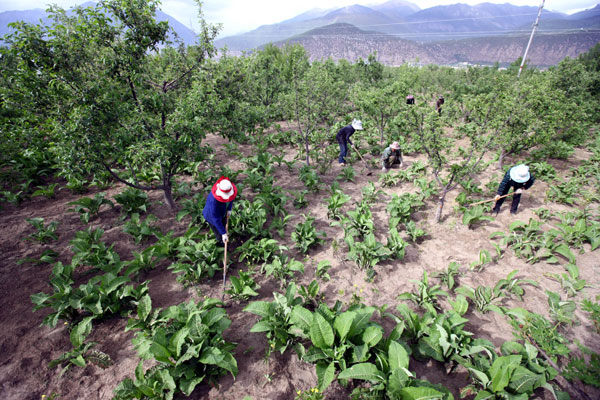Battle to save valuable Tibetan herbs
Updated: 2012-12-27 00:31
By WANG HUAZHONGin Nyingchi, Tibet (China Daily)
|
|||||||||
Sangye seldom opens his collection room to visitors. The room is dark and chilly, and guarded by a mastiff dog attempting to break its chain.
However, inside the room Sangye's collection is not diamonds and gold, but a couple of piles of seeds.
 |
|
Farmers work in a field of herbs in Nyingchi, the Tibet autonomous region, in May 2011. Wang Ying / Xinhua |
The 28-year-old is a specialist at the Tibetan medicine research and experiment base in Mainling county — locally known as "the land of herbs" — in Nyingchi prefecture, the Tibet autonomous region.
The base hires about 300 locals to plant the seeds Sangye toiled to collect from the wild.
"Few people knew of Tibetan medicine in the past. But as more people in China and around the world start to look into the ancient science for health, Tibetan herbs are being depleted," he said.
Mainling lies at the middle reaches of the Yarlung Zangbo River, and between the Tangula Mountains and the Himalaya Mountains at an average 3,700 meters above sea level. The county is regarded as the origin of Tibetan medical science.
The local government said Mainling has about 3,800 types of plants and 680 types of macro fungi. About 1,300 years ago, the founder of Tibetan medical science, Yuthok Yonten Gonpo, is said to have trained doctors at the Ganlu Cave in the county.
However, Sangye said locals have dug out most of the herbs they could find. Some of the herbs are so scarce that it took Sangye and two colleagues six months to collect less than half a kg of seeds of large leaf gentian, a key ingredient for a treatment to combat rheumatism.
Sangye said the large leaf gentian was "everywhere" when he was a child, and he followed his grandfather to gather herbs when he was 4 years old.
"It's time for us to plant to protect the wild species. We need to pass the assets down for the next generations," said Sangye, who is also a graduate student of the Tibetan Traditional Medical College.
"Domestication of wild herbs is not easy and requires careful control of conditions including exposure to sunshine, temperature and humidity. We don't have enough technical staff to do research and train farmers at the same time.
"This is a long-term project."
Growing herbal plants brings economic benefits to locals, said Pema Yeshi, deputy director of the county's agriculture and animal husbandry bureau.
Pema Yeshi said the ecological system of the plateau is very fragile. The local government forbade tree logging in the 1990s and the policy reduced many people's incomes.
"We established the herb base, trained more than 1,000 people and developed it into a demonstration project that encourages locals to shift to a high-profit business."
The county government also gave out seeds for free and subsidizes farmers 8,100 yuan ($1,300) for every hectare of land growing herbs. When the harvest is ready, the county buys the herbs and sells them in the market.
The base has succeeded in planting 11 kinds of herbs, such as saffron, on 8 hectares of land. Farmers living nearby shifted from growing agricultural products to herbs on 12 hectares of land since 2010.
Local herb collector Zomkyi, 48, said growing herbs not only generated 30,000 yuan of income for her family this year, but also changed her lifestyle. Her family had to travel into the mountains to find herbs four years ago.
"For every trip, we brought food, drinks and tents with us and spent a week in the mountains. It was very dangerous. Some herbs grow on the cliffs."
Zomkyi said she will not have to risk her life any more.
Contact the writer at wanghuazhong@chinadaily.com.cn

 Relief reaches isolated village
Relief reaches isolated village
 Rainfall poses new threats to quake-hit region
Rainfall poses new threats to quake-hit region
 Funerals begin for Boston bombing victims
Funerals begin for Boston bombing victims
 Quake takeaway from China's Air Force
Quake takeaway from China's Air Force
 Obama celebrates young inventors at science fair
Obama celebrates young inventors at science fair
 Earth Day marked around the world
Earth Day marked around the world
 Volunteer team helping students find sense of normalcy
Volunteer team helping students find sense of normalcy
 Ethnic groups quick to join rescue efforts
Ethnic groups quick to join rescue efforts
Most Viewed
Editor's Picks

|

|

|

|

|

|
Today's Top News
Health new priority for quake zone
Xi meets US top military officer
Japan's boats driven out of Diaoyu
China mulls online shopping legislation
Bird flu death toll rises to 22
Putin appoints new ambassador to China
Japanese ships blocked from Diaoyu Islands
Inspired by Guan, more Chinese pick up golf
US Weekly

|

|







